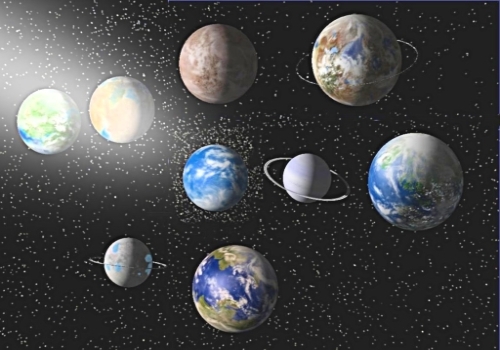BY LETTER
Systems and Worlds
 Image from Steve Bowers |
The foundation of the Galactic Civilization is the solar system. Without the powerhouse of a star to provide raw energy (and sometimes mass for exotic matter conversion) and its family of planets, moons, comets, asteroids, and planetesimal, there could no interstellar society. Civilization expands throughout the universe, making barren space bloom with new life, both biological and aioidal. In the vastness of space, the frontier is endless, resources are limitless, and there is untold wealth to be made by hardy developers, prospectors and colonists who wish to stake their claims and are lucky enough to succeed.
Colonization is never easy. There are hazards in deep space, and very few planets are habitable by baseline Terragen life. Newly claimed solar systems almost always contain nothing but inhospitable planets or asteroids, and sometimes not even that. Terraforming can modify the choicest worlds, making them earthlike, but for the rest C-O life (aerobic carbon-based) depends on sealed domes, habitats, and orbital settlements for living space. Some tweaks are gengineered or bioborgised to live in exotic environments, while xenosophont races like the To'ul'hs are able to live in exotic environments that are difficult to modify for any Terragen metazoa, and vecs and neumanns are able to survive in a wider range of environments than any biologicals, including in a vacuum, provided there is shielding from hard radiation.
Planets, moons, asteroids, comets - all provide resources, the opportunity to build habitats and cities and support population and industry. Apart from planets and medium to larger moons, they eventually become so honeycombed through mining and development and habitatization, so filled with industry and commerce and equipment and living space and biospheres, as to become cities and gardens in space. Very few of the citizens of the galaxy actually even live on the surface of a planet.
In the Current Era, the Terragen Sphere encompasses some one billion star systems, with the Sephirotic Empires and aligned polities occupying around 320 million of that number. A relatively small number of star systems contain populations in the quadrillions or even more than a quintillion. Many of these are Matrioshka Brains and Dyson Swarms made of computronium and running cybercosms populated by virtual sophonts, while others are megastructures of many different types populated by varying mixes of embodied sophonts living on or within them and virtual sophonts running on computronium nodes built into the local infrastructure.
Populations in most star systems range from a few hundred million to a few tens of billions, although systems with population counts a few orders of magnitude higher or lower are not uncommon. A small minority of systems, more commonly but by no means always in the Outer Volumes and Periphery, have populations that are much lower, sometimes a few dozen or less.
Sub-Topics
| Systems & Worlds 0 - 9 | Systems & Worlds A - B | Systems & Worlds C - D |
| Systems & Worlds E - F | Systems & Worlds G - H | Systems & Worlds I - J |
| Systems & Worlds K - L | Systems & Worlds M - N | Systems & Worlds O - P |
| Systems & Worlds Q - R | Systems & Worlds S - T | Systems & Worlds U - V |
| Systems & Worlds W - X | Systems & Worlds Y - Z |
Related Topics
Development Notes
Text by M. Alan Kazlev
Amended 6 October 2022
Initially published on 05 August 2001.
Amended 6 October 2022
Initially published on 05 August 2001.
Additional Information






